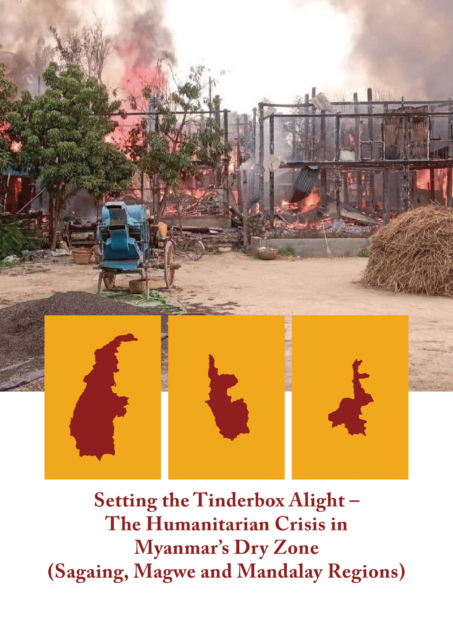Report
2131 Views
Setting the Tinderbox Alight — The Humanitarian Crisis in Myanmar’s Dry Zone
August 31st, 2022 •
Author:
Progressive Voice
•
4 minute read

This briefing paper highlights the immense challenges and local responses to the humanitarian crisis on the ground in Sagaing, Magwe and Mandalay Regions since 1 February 2021. This paper sheds light on the situation for those internally displaced in the three regions, and advocates for a solidarity approach to humanitarian assistance – one that places local humanitarian actors at the center of the solution to the humanitarian crisis, that focuses on channeling funds directly and flexibly to local organizations, and that includes support for the extension and strengthening of cross-border aid channels.
Key Messages:
- Over 18 months since the attempted coup launched by the Myanmar military junta, little concrete action has been taken by the international community, particularly ASEAN, to mitigate the horrific humanitarian fallout on the ground. The scale of this crisis and immense human suffering in Myanmar’s Dry Zone caused by the junta should be ringing alarm bells. Political actors must devise solutions for a multilateral emergency response that includes a coordinated aid mission and swaths of targeted sanction
- Internally Displaced Persons (IDPs) are in acute need of food, medicine, shelter, clothing, vehicles to get to and from IDP sites, and the restoration of full internet access. Multiple interviewees for the paper expressed that international aid actors were not present in Myanmar’s Dry Zone regions, with IDPs being supported financially and subsisting on aid provided by networks of local humanitarian and civil society groups, diaspora communities, local administration forces of the revolution, the National Unity Government (NUG), neighbors, relatives and friends.
- The Myanmar military, both historically and since 1 February 2021, uses humanitarian aid as a weapon; they repeatedly block, confiscate, destroy and manipulate the distribution of aid for their political and strategic advantage. The junta has also seized medical facilities and continuously attacked humanitarian aid and medical workers.
- Providing humanitarian aid in partnership with the terrorist military junta, the root cause and architect of the crisis, will continue to violate international humanitarian principles, particularly the principles of do no harm, neutrality and impartiality, while only exacerbating conflict and human suffering, failing to reach those in need.
- Attempts made by international humanitarian actors to coordinate, work or partner with the military junta in the distribution of aid have not reached those most in need – being blocked access to regions or denied out of hand. Responses from local community actors, civil society and humanitarian organizations have been most effective in reaching those in dire need, despite the junta’s disruptions of the distribution of aid.
- Under the Five Point Consensus, ASEAN has completely failed to yield any meaningful results for those on the ground in Myanmar and the regional bloc must move beyond the consensus. ASEAN and the AHA Centre must suspend attempts to partner with the junta in order to address the Myanmar’s multidimensional crisis, including the provision of aid.
- The UN, States, ASEAN and international humanitarian actors must employ a solidarity approach to the distribution of humanitarian aid – putting the welfare, human rights, human security and agency of displaced communities and local humanitarian actors at the center of solutions to the humanitarian crisis in Myanmar.
- In solidarity with the people of Myanmar there must be a meaningful commitment to the localization of aid using local frameworks, in recognition of the agency, leadership and effectiveness of local actors
- Actors engaged in humanitarian activities in Myanmar (including States, donors, the UN and ASEAN), must apply funds directly and flexibly to local humanitarian organizations so that they are able to respond in a timely and effectively manner to the crisis on the ground. Concurrently, they must relax onerous reporting requirements to allow civil society and local humanitarian organizations to focus on the emergency situation at hand. Cross-border aid does not stop in ethnic border areas, with support and funding, it can reach communities in Myanmar’s Dry Zone.


